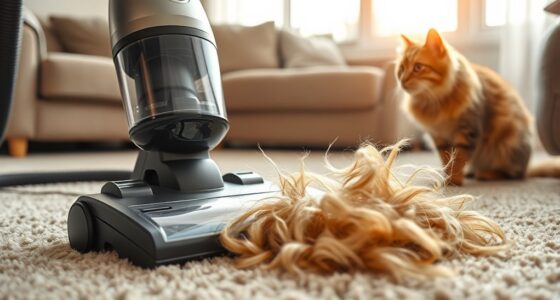During construction or renovation, effective dust control involves using high-quality vacuums with HEPA filters to trap fine particles at the source. Make sure you vacuum frequently and thoroughly on surfaces, tools, and equipment. Wear protective gear like masks, gloves, and eye protection to avoid inhaling dust. Combine vacuuming with air filtration devices to improve indoor air quality further. Staying proactive with these strategies helps keep dust minimal; explore more tips to enhance your dust control plan.
Key Takeaways
- Use industrial-grade vacuums with HEPA filters for effective dust containment at the source.
- Incorporate frequent, thorough vacuuming of surfaces, tools, and debris to prevent dust accumulation.
- Equip workers with protective gear like respirators and coveralls to minimize dust inhalation and transfer.
- Combine vacuuming with portable HEPA air scrubbers to enhance overall air filtration and reduce airborne dust.
- Focus on cleaning floors, walls, ceilings, and equipment regularly to maintain a cleaner, safer work environment.

During construction or renovation, controlling dust is essential to protect your health and maintain a clean environment. Dust particles can become airborne easily and spread throughout the space, posing health risks and complicating cleanup efforts. One of the most effective strategies to minimize dust dispersion is vacuuming, especially when combined with proper air filtration and protective gear. Using industrial-grade vacuums equipped with HEPA filters ensures that dust is captured at the source, preventing it from recirculating into the air you breathe. These vacuums are designed to trap even microscopic particles, making them invaluable for maintaining indoor air quality during messy projects.
Controlling dust during construction with HEPA vacuuming and air filtration protects health and maintains cleanliness.
When vacuuming during construction, you should focus on frequent, thorough cleanups of surfaces, tools, and debris. This prevents dust from settling and becoming embedded in surfaces, which can be difficult to remove later. It’s essential to vacuum not only floors but also walls, ceilings, and any equipment or materials that generate dust. This proactive approach reduces the overall airborne dust load, making subsequent air filtration more effective. Additionally, choosing the right vacuum technology can significantly improve dust containment and removal. Remember, consistent vacuuming paired with high-quality air filtration systems creates a cleaner, safer workspace by continuously removing dust particles from the environment.
Wearing protective gear is equally important during these cleaning efforts. Respirators or dust masks help you avoid inhaling harmful particles, especially when vacuuming dusty materials. Eye protection, gloves, and coveralls further shield your skin and eyes from airborne debris and contact with dust-covered surfaces. Proper protective gear ensures you can work safely and comfortably, reducing health risks associated with prolonged dust exposure. It also minimizes the transfer of dust to other areas, helping contain the mess and maintaining a healthier environment.
In addition to vacuuming and protective gear, enhancing your air filtration setup is crucial. Portable air scrubbers with HEPA filters can be strategically positioned around the worksite to continuously clean the air. These units pull in contaminated air, filter out dust particles, and release cleaner air back into the space. When used alongside vacuuming, air filtration markedly lowers airborne dust levels, improving air quality and reducing the likelihood of dust-related health issues.
Frequently Asked Questions
Can Vacuuming Remove All Types of Construction Dust Effectively?
Vacuuming can’t remove all types of construction dust effectively, especially fine particles. Using a vacuum with HEPA filters helps trap tiny dust mites and allergens, improving air quality. Make certain proper dust containment by sealing off work areas and using the right equipment. Regular vacuuming with HEPA-filtered vacuums minimizes dust spread, but complete removal requires combined strategies like dust containment and proper cleaning techniques.
How Often Should Vacuuming Be Performed During Renovation Projects?
You should vacuum frequently during renovation projects, ideally at least once a day, to keep dust accumulation rates manageable. Regular vacuuming helps prevent dust from settling deeply into surfaces, making cleanup easier and reducing health risks. Increase vacuuming if dust levels rise or if you’re working in high-dust areas. Consistent effort guarantees your space stays cleaner, safer, and more comfortable throughout the renovation process.
What Equipment Is Best for Dust Control in Construction Sites?
You should choose equipment with HEPA filtration, as it captures 99.97% of airborne particles, guaranteeing top dust control. HEPA vacuums are highly durable and designed for heavy-duty use, making them ideal for construction sites. Investing in reliable, robust equipment minimizes dust spread, improves air quality, and protects your team’s health. Durability ensures long-term performance, saving you money and reducing downtime during your renovation project.
Are There Specific Vacuum Filters Recommended for Construction Dust?
You should use vacuum filters with HEPA filters for construction dust, as they effectively trap tiny particles and prevent dust escape. HEPA filters are recommended because they provide superior dust containment, ensuring cleaner air during and after cleaning. Make sure your vacuum is designed for construction debris and regularly check the filters to maintain ideal dust control, reducing health risks for workers and occupants.
How Does Vacuuming Impact Indoor Air Quality During Renovation?
A stitch in time saves nine, so vacuuming during renovation markedly improves indoor air quality by reducing airborne particles and allergens. Your efforts help mitigate dust that can settle on surfaces and become airborne, leading to healthier indoor environments. Regular vacuuming, especially with HEPA filters, enhances airborne particle reduction and allergen mitigation, ensuring you breathe cleaner air and protect your family from potential respiratory issues during construction.
Conclusion
By implementing effective dust control strategies, you protect your health and maintain a cleaner workspace during construction or renovation. For example, imagine a homeowner who used vacuuming and dust barriers consistently—she finished her project without a single dusty complaint from neighbors. Stay proactive, keep dust at bay, and enjoy a safer, cleaner environment throughout your renovation. Proper dust management isn’t just a tip; it’s a game-changer for your project’s success.









